
Johan Christian Fabricius was a Danish zoologist, specialising in "Insecta", which at that time included all arthropods: insects, arachnids, crustaceans and others. He was a student of Carl Linnaeus, and is considered one of the most important entomologists of the 18th century, having named nearly 10,000 species of animals, and established the basis for the modern insect classification.

Pentatomidae is a family of insects belonging to the order Hemiptera, generally called shield bugs or stink bugs. Pentatomidae is the largest family in the superfamily Pentatomoidea, and contains around 900 genera and over 4700 species. As hemipterans, the pentatomids have piercing sucking mouthparts, and most are phytophagous, including several species which are severe pests on agricultural crops. However, some species, particularly in the subfamily Asopinae, are predatory and may be considered beneficial.
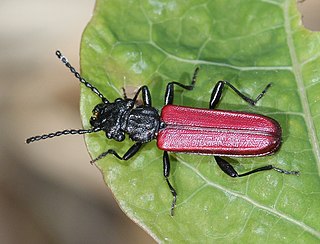
The Cucujidae, "flat bark beetles," are a family of distinctively flat beetles found worldwide under the bark of dead trees. The family has received considerable taxonomic attention in recent years and now consists of 70 species distributed in five genera. It was indicated Cucujus species are scavengers, only feeding on pupae and larvae of other insects and on other subcortical beetles such as their own. Since the Cucujidae prey on larvae of potentially tree damaging beetles that spread fungal diseases, they are considered to be beneficial to the health of living trees.
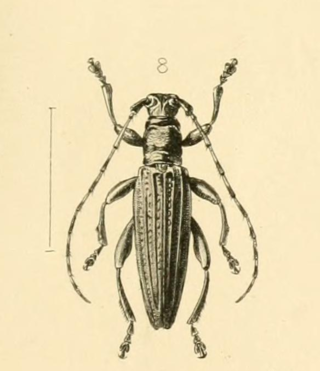
Xylotoles is a genus of beetle in the family Cerambycidae. It contains several species, including Xylotoles costatus, once thought extinct. The longhorn beetles belonging to genus Xylotoles is classified as Endangered (EN) on the IUCN Red List.
Troginae is a subfamily of beetles in the family Trogidae which includes extant species and extinct beetle species from the Lower Cretaceous. The subfamily contains the following genera:

Troilus luridus, also known as the bronze shieldbug, is a species of shield bug found in Europe. It was first described by the Danish zoologist Johan Christian Fabricius in 1775. Shieldbugs are generally phytophagous and some, including Troilus luridus, are also carnivorous and will eat the larvae of beetles, lepidoptera and sawflies.
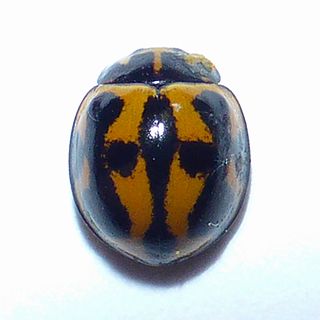
Coelophora inaequalis, the variable ladybird, common Australian lady beetle or common Australian ladybug is a ladybird species endemic to Australia, Oceania and Southern Asia. The variable ladybird gets its name from the black markings on the adult elytra, that vary from one individual to another.

Onthophagus is a genus of dung beetles in the Onthophagini tribe of the wider scarab beetle family, Scarabaeidae. It is the most species-rich and widespread genus in the subfamily Scarabaeinae, with a global distribution.

Heliocopris is a genus of Scarabaeidae or scarab beetles in the superfamily Scarabaeoidea. Forty-seven of the fifty-two known species are found in Africa, but some are found in southern and southeast Asia.

Rhagium is a genus of flower longhorn beetles in the family Cerambycidae, Cerambycidae.
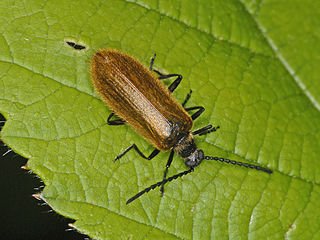
Lagria is a genus of beetles in the family Tenebrionidae.
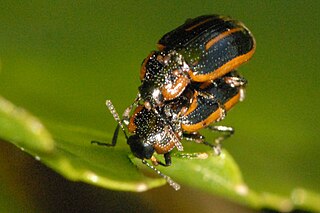
Hydrothassa hannoveriana is a species of leaf beetle in the family Chrysomelinae. It is found in Europe.
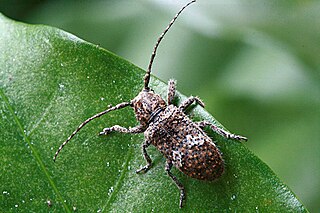
Rhytiphora bankii is a species of beetle in the family Cerambycidae. It was first described by Johan Christian Fabricius in 1775, under the genus Lamia. It is known from Australia, the Philippines, Borneo, Java, Micronesia, New Guinea, Hawaii, Moluccas, Sumatra, Vietnam, and has been introduced into Japan. The Australian species of Prosoplus were synonymised with Rhytiphora in 2013.

Crudosilis ruficollis is a species of soldier beetles native to Europe.

Bodiloides ictericus is a species of dung beetle in the family Scarabaeidae, found in the Palearctic. It is one of more than 50 species in the genus Bodiloides.

Bodilopsis sordidus, commonly known as the Brown domino beetle, is a species of scarab beetle found in the Palearctic. This species was formerly a member of the genus Aphodius.
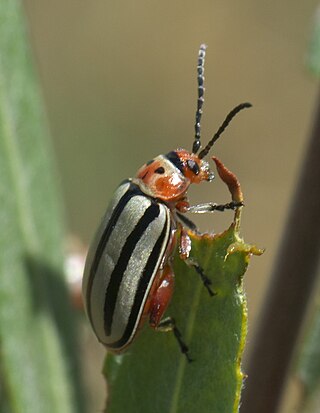
Disonycha is a genus of flea beetles in the family Chrysomelidae, containing some 170 species in the Nearctic and Neotropics.
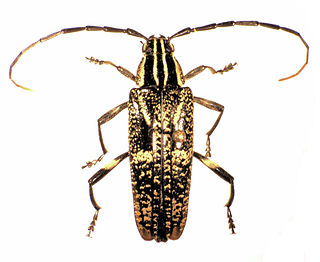
Coptomma is a genus of beetles belonging to the family Cerambycidae.

















